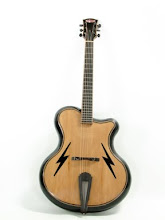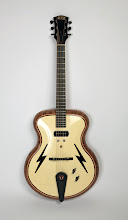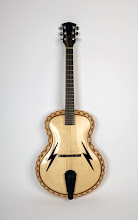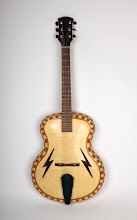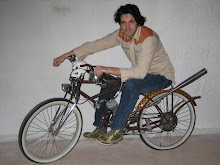



The newest Dagmar Custom Guitar has begun. This is the most complicated pattern to date and was inspired by my clients. Their request was for a sharks tooth pattern as depicted by a sketch that they sent. At first I thought no, it can't be done. But I couldn't just let the idea go. I became obsessed and began to sacrifice sleep to see at least how close I could come to the original sketch using my construction methods. I sat in my shop, hovered over my bench and began to draft out the intended double cutaway body shape. A tooth pattern? How in the heck do I do that?
With some practical drafting I had a eureka moment and was able to come up with a fairly close derivative of the client's sketch. The key to figuring it out was to have two constants. The teeth had to be the same all the way around and the pattern would have to be at a constant interval around the perimeter of the sound plates. So, in comparison to all the guitars before, I was able to see that the rim would have to be figured out using the inside perimeter as the reference point vs the out side perimeter. I had to double the amount of segments and quadruple the angles.
I had just enough left over pieces from Gretchen to do three test segments to help illustrate what the pattern would look like. With the transitioning and connecting radius that make up the rim the space between each tooth would have to expand or shrink to follow the guitar's curves.
This revelation was pretty exciting but I was initially reluctant to say yes to the client. Doubling the cuts and quadrupling the angles means that my tolerances would have to be just that much more tight. However, I felt as if I
needed to build this guitar and I became totally inspired by the challenge.
The rim is basically two rims zippered together. The base of each segment is 3/8" and as stated above, each tooth is exactly the same. The dark maple in between is forever changing all the way around. There were times of panic as I was piecing the segments together but I remained in the mind set to go slow and get her done. And suddenly it was. And it worked! And I love it!
I did veer off the drafting a bit from time to time but I was able to back up and correct things. I also tweaked the upper horns of the cutaway. The drafting allowed for 3 teeth in the super tight radius and it simply did not look right - it looked to spacious. The decision to sneak a 4th tooth in was made. A bit of freestyle math was successfully exercised and the result looks much better.
The next step is to fair the inside concave surface to prep for the carbon fiber inlays. After that I will define the sound plate perimeter and rout in the glue shelf which is the equivalent of a traditional guitar's kerfing.













